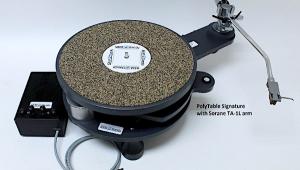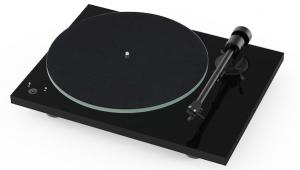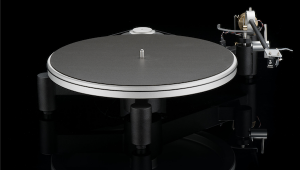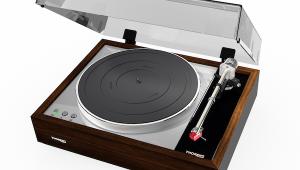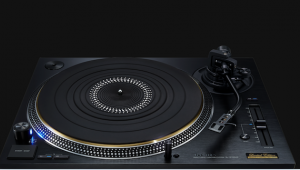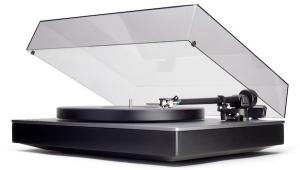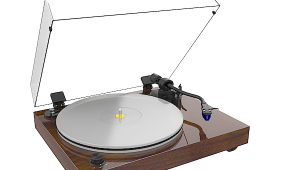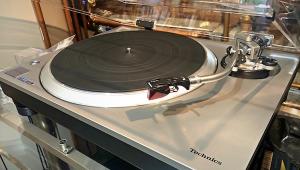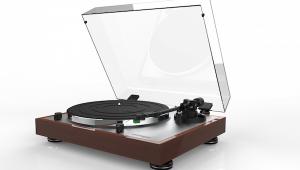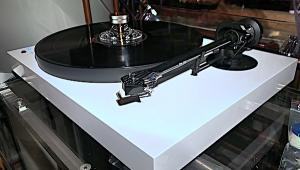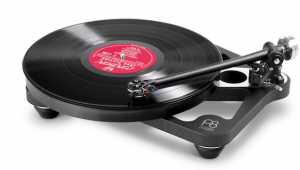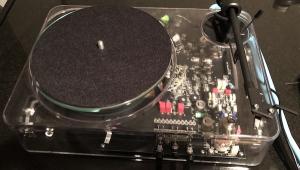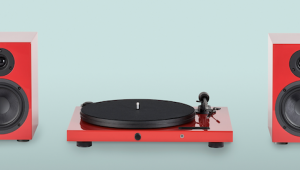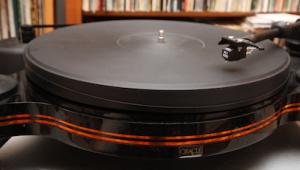Linn LP Playing System Page 2
The Linto's small size and weight results from Linn's use of its Brilliant (their name) switch-mode power supply, which uses neither a large transformer nor soda-can-sized capacitors. Instead, it converts incoming AC to high-voltage DC, then "chops it up" (Linn's words) at a very high frequency before feeding it to a small (30mm square) transformer whose output is then converted back to very smooth DC. Linn says it took two years of research and experimentation to get this to work.
Connecting the Linto is easy. It has three pairs of RCA jacks: one input, two outputs.
Setup after setup
Perhaps it's just my analog orthodoxy, but I left the LP12's dustcover off: I don't like large soundwave-catching resonators attached to turntables. That left Linn's orthodoxy—a felt mat—free to catch dust, so I didn't use it either, since my job description doesn't include ruining my records from dust infestation. Instead, I used a Ringmat during the break-in period, and only after that did I substitute the felt met for a spell so I could listen to the "stock" system. The Ringmat sounded better, wasn't a dust magnet, and didn't come up with the record and head eastward, threatening the cantilever's health and well-being.
(Linn suggests using double-stick tape if the mat comes up. No thanks. Let true believers use the felt mat. Let them also swallow Linn's line about cleaning records: "Most record cleaning devices do more harm than good. We feel the best method is to let the stylus remove any dirt which may be in the groove, then clean the stylus." Right.)
Linn also suggests siting the LP12 on "a small light, rigid table, e.g., small coffee table." I don't have such a table, so the Sondek was placed on the solid-maple top shelf of my Finite Elemente Pagode stand.
Value and Sound
This may be a review of a system, but the LP12 is still the central component, and it's somewhat intimidating writing about the turntable that, in 1972, turned audio upside down and sent turntables back to belt drive. Three decades later, the LP12 continues its strong hold on hordes of Linnies. Do an online search on the word "Sondek" and you'll confront the "true believers" head on. I don't want to mess with them, but here goes:
I've spent the past eight years listening to all manner of analog gear, from a $29,000 phono section to a $74,000 turntable. I've heard some astounding stuff, and I own some that's pretty good. I can't step into this review and tell you that my life has been changed by listening to the LP12, that formerly I hadn't ever found the Holy Grail but that now, for the first time, blah blah blah. I can tell you that, at $2030, the LP12 is an outstanding piece of mechanical engineering undiminished by time.
Vinyl playback is considered quaint by mainstreamers, so the compact, retro-looking LP12 must be quaint squared. Its homely looks and ease of operation, though, are to be admired. It's not a piece of audio jewelry, or a rocket ship, or a sculpture: it plays records using a design that makes sense. It's a gentleman's turntable, a piece of machinery of sensible form and function.
The LP12 has a reputation for being tweaky. But once my review sample was properly set up, I found it anything but—at least over the short haul. You need the Lingo to get the platter spinning, so a functioning LP12 actually costs $3580.$s1 But even at that, I think the LP12-Lingo is priced fairly. It ran precisely at 33 1/3 and 45rpm—a good start. Having already put the $1500 Walker Motor Controller on my $12,500 Simon Yorke turntable and experienced a major improvement, I take the word of those who came before me that the Lingo upgrade wrought a serious upgrade in the LP12's performance.
$2695 is a lot to pay for a tonearm—especially one like the Ekos, which doesn't provide on-the-fly adjustability of vertical tracking angle (VTA), if you require that. For about the price of the Ekos, you can get the Graham 2.2, the SME IV.Vi, the Tri-Planar VI, or the VPI JMW Memorial. There's other competition as well: the Naim ARO, the Immedia RPM-2, the Rega RB1000, and the Morch DP-6. That said, based on listening (within the Linn system) and touching, the fixed-pivot Ekos is competently designed and executed, and sounded and felt competitive with other arms priced at around $3000. I don't want to get into the unipivot-vs-fixed-bearing war.
The Linn Akiva cartridge is priced craftily at $2950, where there's a hole in the Lyra line: there's nothing between the $2000 Helikon and the $5000 Titan. Though now wearing a Wardrobe by Linn, the Akiva has many telltale Lyra family attributes, both physical and, definitely, sonic. I'm not sure that the Akiva is a Lyra—I'm just guessing in public.
As for the Linto phono preamp, at $1600 it's a major accomplishment in terms of dead quiet (for an AC-powered phono section), timbral neutrality, frequency extension, and overall tunefulness, though I found it slightly prominent or over-extended on top without sounding exactly "bright."
Yup, still stalling. Here goes...
I spent two weeks just listening to LPs, both new and familiar, without comparing the sound to my reference. The first conclusion I drew was that if the early iterations of the LP12 were bloomy and/or sluggish in the midbass, the sound of this new version, with its associate components, wasn't at all. Speakers Corner recently issued Jefferson Airplane's Volunteers (RCA LSP-4238), that notoriously murky and somehow, once again, au courant epic from 1969. Bassist Jack Casady's thunder was deeply rendered, quite articulate, and well separated from the rest of the program, which had great transient clarity and detail. It sounded better than I've ever heard the album—but I haven't played the original orange-label, noisy-brown-vinyl pressing for a long time. Still, I remembered the bottom being deep. It still is, and it didn't phase the LP12.
I switched to something more modern. Chan Marshall's (aka Cat Power) vital, compelling You Are Free (Matador OLE-427), honestly recorded by Adam Kaspar, showed no overt signs of murking up. (If you like Neil Young's Harvest or the Cowboy Junkies' Trinity Session, give You Are Free many listens—it doesn't yield its treasures easily.)
And so it went through the entire catalog of "post-rock" instrumentalists: God Speed! You Black Emperor (Constellation), the amazing-sounding reissue of June Christy's musically sophisticated Something Cool (Cisco), and, for the big test, Audiophile Master Records' reissue of Ray Brown's Soular Energy (originally on Concord Jazz), in which Ray Brown's bass and Gene Harris' piano gang up on your tonearm and cartridge as few records in recent memory have. The Linn system sounded as well-balanced, quiet, clean, detailed, rich, and inviting as you would wish any +$10,000 analog front-end to sound.
I played plenty of classical music too, especially the set of Beethoven's Piano Concertos (Vladimir Ashkenazy, Georg Solti, Chicago Symphony, Decca/London) I've been loving for the past year. Compared to the expectation of "music," I found myself wholly satisfied. The system's overall performance was convincing. It made no obvious mistakes, nor did it have any overriding character that drew attention away from the music.
Lurking behind my positive response was a hunch that could be proven or disproved only by a head-to-head comparison in real time. I dug through my collection for recently reissued albums of which I had duplicates, such as Classic Records' fabulous reissue of Pete Townshend and Ronnie Lane's Rough Mix, Analogue Productions' 45rpm twofer of Little Hatch's Rock With Me Baby, and others. With one copy of each record on the LP12 system ($10,840) and one copy on my combo of Simon Yorke 'table, Graham 2.2 arm, Lyra Titan cartridge, ASR Basis Exclusive phono section, and Vibraplane isolation platform (ca $23,000), I listened, switching between the two rigs via the Halcro dm10 preamp's remote control.
I don't expect enormous timbral differences between analog front-end systems costing around $10,000—especially when the cartridges are made by the same company, as I suspect these were. That was the case during my comparisons, but there were some sonic differences that remained constant as the records changed. One of these had to do with the dynamic differences I usually hear when comparing suspended and rigidly mounted turntables. The Linn system consistently sounded ever so slightly soft compared to the Yorke. The difference was so subtle that it wasn't apparent except through a direct A/B comparison. Even then, they seemed like adversaries standing directly to either side of an artificially drawn border—which side I might prefer to join was simply a matter of taste. Jimmy D. Lane's acoustic guitar on Rock With Me Baby sounded wonderfully lush and woody via the Linn, somewhat more wiry and percussive via the Yorke. Same guitar, slightly different tonal and spatial presentations.
When I first heard the original Graham tonearm years ago, back when I'd not yet heard a top-performing arm in my system, I heard spatial details carved out as never before—I could especially sense the isolation booth in which Joni Mitchell recorded her vocals for Court and Spark. The biggest differences I heard during the Linn A/B sessions involved image focus, spatial context, and bass dynamics. There's a positively holographic cowbell on "Misunderstood," from Rough Mix. It sounded convincing on both rigs, but on the Yorke it stood out from the reverb with greater relief, and "popped" in 3D; it was a bit more subdued via the Linn. Through the Yorke system, Little Hatch's voice hovered convincingly farther forward in the mix, and was somewhat better focused.
When I played the Cat Power album for the first time on the Yorke, after having first gotten to know it on the Linn, I was surprised by how the subtle differences delivered a very different experience: less of a musically cohesive whole, but far more time and space detail. Background vocals that I knew well now had specific places from which they were being sung, the background singers assuming more compelling personal identities. So did Chan Marshall herself. I was able to "see" her more clearly and intimately, perhaps somewhat at the expense of the musical whole.
Another consistently noted difference was the Linn's more open sound on top. There was a slight bit of rise to the top end that didn't result in brightness per se, but in an exaggeration of noise within the source, such as tape hiss.
Given that the Linn array costs less than half the price of the Yorke and its associated gear, I'd say that's a very impressive showing—especially considering the modest cost of the Linto compared to the $4950 ASR Basis Exclusive, which I think is among the best phono preamps I've ever heard.
Conclusions
I've poked some fun at Linn's visionary leader, Ivor Tiefenbrun, but I have nothing but respect for him and for his products—including the Sondek LP12. Everything its fans say about it is true: It can carry a tune, it's well-paced, and it has impressive bass extension and supple and believable bass "transients" (in quotes because the leading edge of a bass note is not actually in the bass range, but never mind). More important, the whole Linn picture hung together seamlessly, as you should expect from any front-end rig costing more than $10,000. The system, as reviewed, was super-quiet. It didn't sound soft or mushy in the bass, nor did it sound old-fashioned. It had a rich, believable midband and fast, clean high-frequency transients. The soundstaging and imaging were excellent, though I've heard greater focus and resolution of low-level spatial (though not musical) detail.
The Sondek LP12 remains in production because it was a good design to begin with, has since only improved, and is still competitive in its price class and beyond—especially when combined with Linn's ancillary products. It was a system I could easily live with: what it did right was seductively musical, and its errors were minor and mostly of omission. Can you get more "snap," space, and focus by playing your vinyl on another system? Yes. Greater dynamic slam, especially at the very bottom? Sure. Blacker blacks? Yes. But you'll pay a great deal more for that other system, and not everyone will find value or even pleasure in the improvements gained.
On balance, the complete Linn system is not the best analog front-end I've ever heard, but it is among a handful that I could easily live with because it made music that was believable.
- Log in or register to post comments


